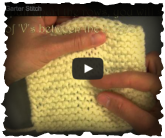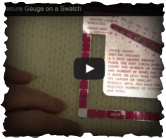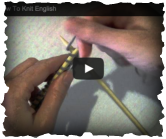How to Knit a gauge swatch (in Stockinette st and garter st border)
|
Why to knit a Gauge Swatch
Stitches Per Inch To Make It Fit Gauge consists of three parts: the yarn, the needles and YOU (i.e. your tension). When preparing to knit something that you want to fit (like a hat, a sweater, socks, etc) it is important to knit a gauge to match the tension of the pattern. Though it is good practice to always knit a gauge swatch, sometimes you can get away without measuring gauge for things like scarves, dish towels or blankets, as long as you don't care what size they turn out. Basic Gauge Pattern Here's the basic pattern for knitting a gauge swatch. See this page to measure your gauge! Abbreviations CO = Cast On sts = stitches K = knit P = purl BO = Bind off St st = Stockinette st = Alternate rows of knit and purl Garter st = Knit every row Directions CO 20 sts. Rows 1-4: Knit 4 rows in garter st. Rows 5-20: Knit 16 rows in St st. Rows 21-24: Knit 4 rows in garter st. BO. Notes: The edges in stockinette st will naturally curl up. If you prefer the whole thing lays flat, follow this alternate gauge swatch instructions: Alternate Gauge Pattern Directions CO 24 sts. Rows 1-4: Knit 4 rows in garter st. Row 5: Knit all sts. Row 6: K2, P20, K2. Rows 7-20: Repeat rows 5 & 6 seven more times (each). Rows 21-24: Knit 4 rows in garter st. BO. |
How to identify knit stitches
 How to identify knit stitches How to identify knit stitches
Learn how to identify what stitches look like when they are knitted. Hint: they look like little Vs when right up against the needle.
Advanced Step: How to identify Purl stitches
 How to identify purl stitches How to identify purl stitches
Learn how to identify what stitches that were purled look like. Hint: they look like little bumps right up against the needle.
|




